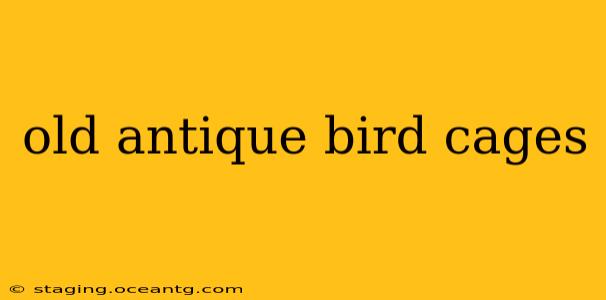Antique bird cages offer a fascinating glimpse into the past, reflecting changing styles, materials, and societal attitudes towards avian companions. From ornate Victorian masterpieces to simpler, utilitarian designs, these cages tell a story, making them highly sought-after collectibles. This guide explores the world of antique bird cages, covering their history, identification, restoration, and value.
What Makes an Antique Bird Cage Valuable?
Several factors contribute to the value of an antique bird cage. Rarity is key – unique designs, unusual materials, or makers' marks significantly increase value. The cage's condition is also crucial; well-preserved pieces with minimal damage command higher prices. The age of the cage plays a role, with older pieces generally being more valuable, though exceptions exist depending on style and provenance. Finally, the cage's aesthetic appeal, including intricate detailing, craftsmanship, and overall artistic merit, impacts its worth.
How Can I Identify an Antique Bird Cage?
Identifying an antique bird cage involves careful observation and research. Look for hallmarks of age, such as wear and tear consistent with its purported age, patina on metalwork, and signs of repairs from previous owners. Materials offer clues; brass, wrought iron, and wood were common materials in antique cages. Check for maker's marks or stamps, which can help authenticate the piece and determine its origin and age. Online resources, antique appraisal books, and consultations with experienced antique dealers can aid in identification.
What Are Some Common Types of Antique Bird Cages?
Victorian Bird Cages:
Victorian-era bird cages (roughly 1837-1901) are particularly prized. They often feature elaborate designs, incorporating intricate filigree work, colorful enameling, and sometimes even glass or porcelain elements. These cages frequently reflect the opulent tastes of the era.
Edwardian Bird Cages:
Following the Victorian era, Edwardian cages (1901-1910) often retained elements of Victorian craftsmanship but exhibited a shift towards simpler, more streamlined styles. The Art Nouveau influence is sometimes visible in these designs.
Early 20th Century Bird Cages:
Early 20th-century bird cages show a broader range of styles, reflecting the evolving tastes of the time. Some maintained traditional elements, while others embraced Art Deco influences or simpler, more functional designs.
How Do I Clean and Restore an Old Bird Cage?
Cleaning and restoring an antique bird cage requires patience and expertise. Avoid harsh chemicals or abrasive cleaners, as these can damage the delicate surfaces. Gentle cleaning methods, such as using soft brushes, mild soapy water, and specialized metal polishes, are recommended. Any restoration work should be undertaken by a professional conservator to preserve the cage's historical integrity and value.
What Should I Look for When Buying an Antique Bird Cage?
When purchasing an antique bird cage, thorough inspection is vital. Check for damage, signs of repair, and any indication of authenticity. Research the maker and style to determine its potential value and age. Consider consulting with an experienced antique dealer for guidance before making a purchase, especially for higher-value pieces. Be wary of imitations or reproductions presented as authentic antiques.
Where Can I Find Antique Bird Cages?
Antique bird cages can be found in various places, including:
- Antique shops and malls: These are excellent sources for a variety of antique cages, often with detailed descriptions and provenance information.
- Online marketplaces: Websites dedicated to antique sales offer a wide selection, though careful vetting of sellers is essential.
- Estate sales and auctions: These events often feature unique antique items, including bird cages.
- Specialized antique shows: These shows focus on specific periods or types of antiques, allowing focused searching for bird cages.
Are Antique Bird Cages Safe to Use for Birds?
While antique bird cages are beautiful, using them for live birds is generally discouraged. The materials may contain lead-based paints or other toxins harmful to birds. Furthermore, the design and construction of many antique cages may not meet modern safety standards for avian housing. These cages are best appreciated as decorative or collectible items.
How Much Are Old Antique Bird Cages Worth?
The value of antique bird cages is highly variable, depending on factors mentioned earlier (age, condition, rarity, maker, etc.). A simple, well-preserved cage might be worth a few hundred dollars, whereas a rare, exceptionally ornate Victorian piece could fetch thousands. Professional appraisals are recommended for accurate valuation, especially before selling a piece.
This guide provides a starting point for exploring the fascinating world of antique bird cages. Remember that careful research, responsible sourcing, and an appreciation for the historical context are essential for every collector.
